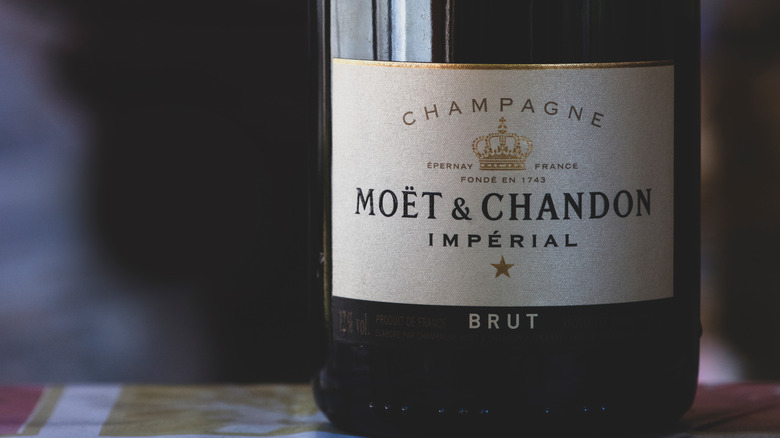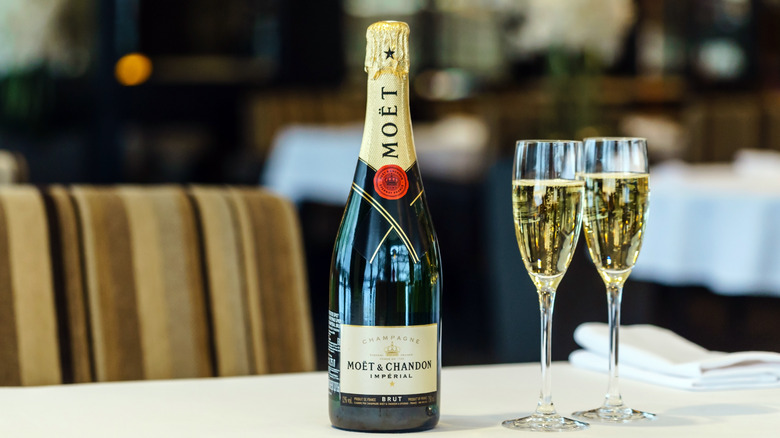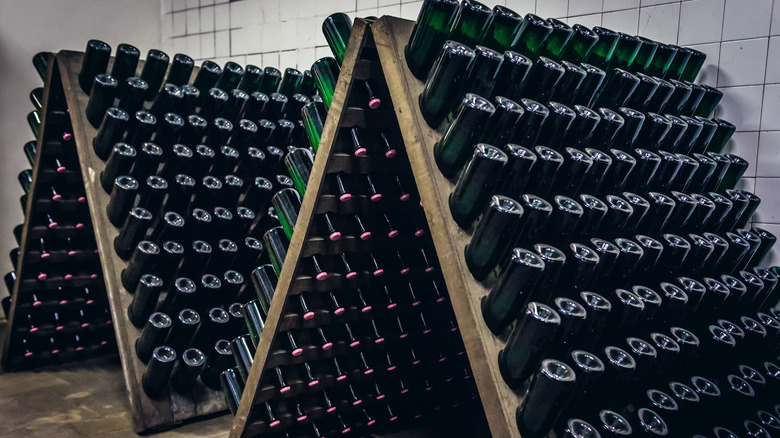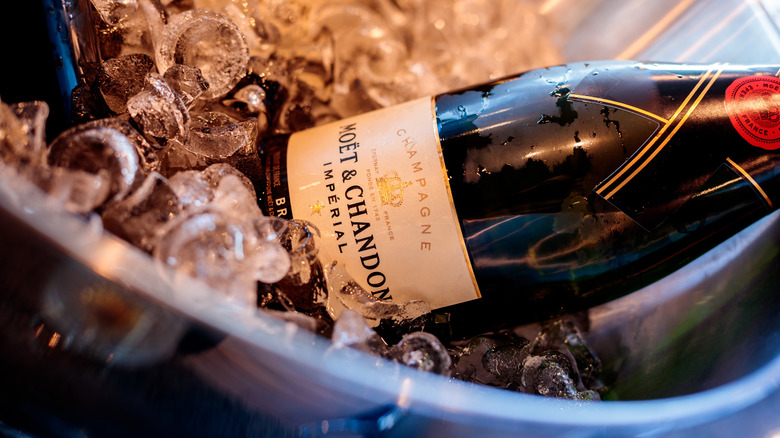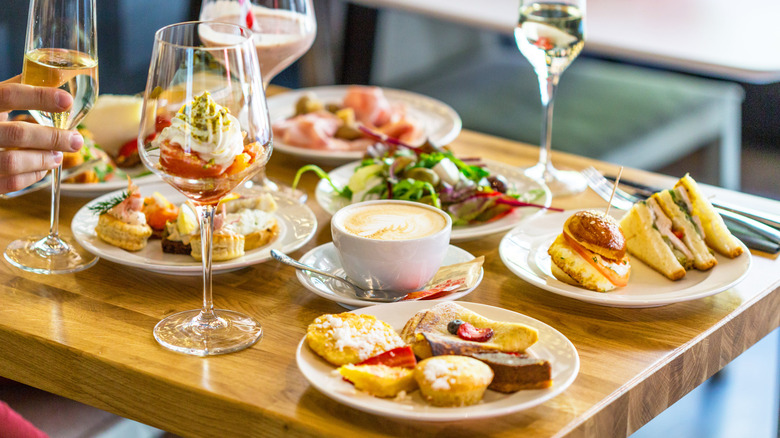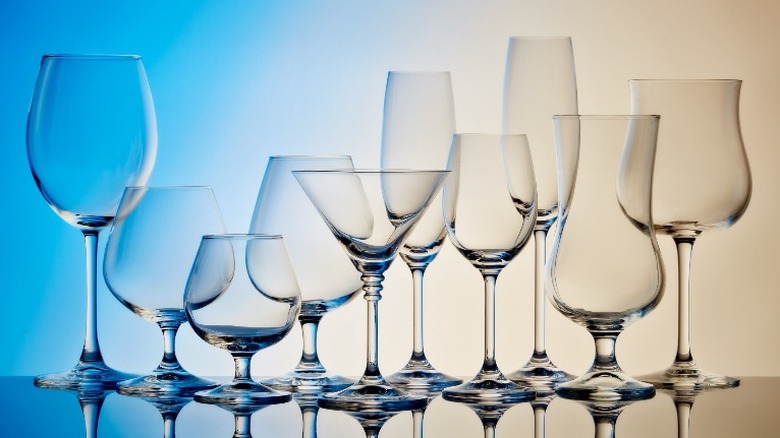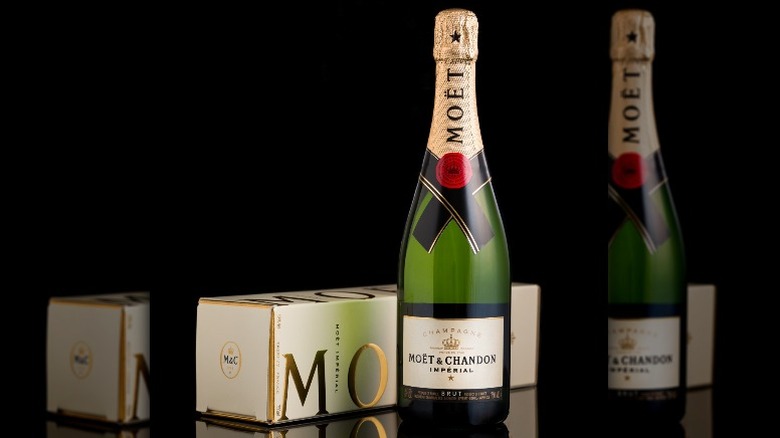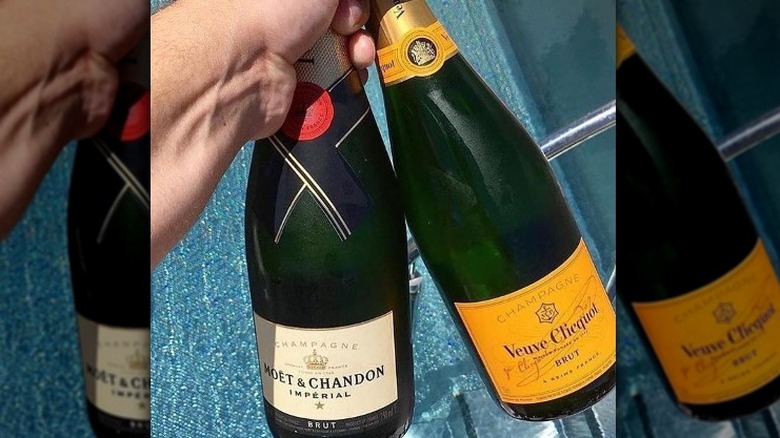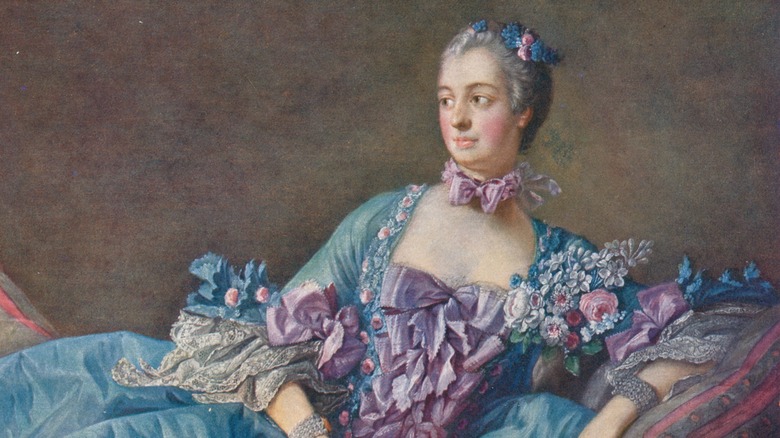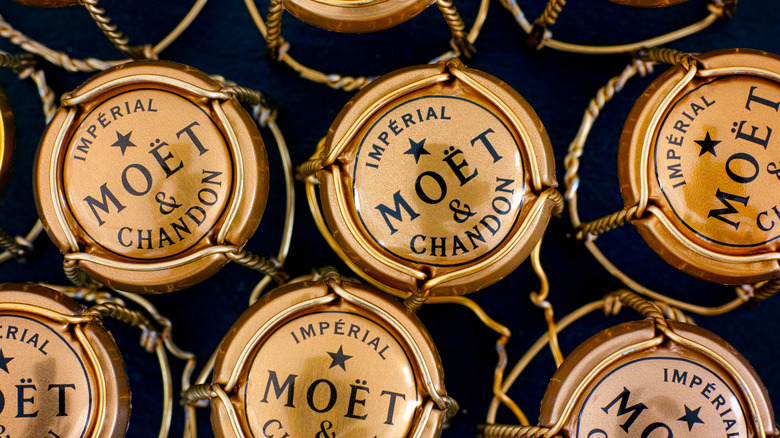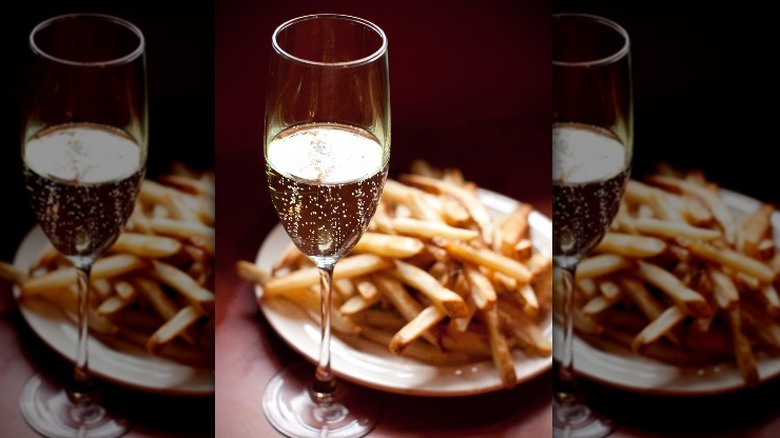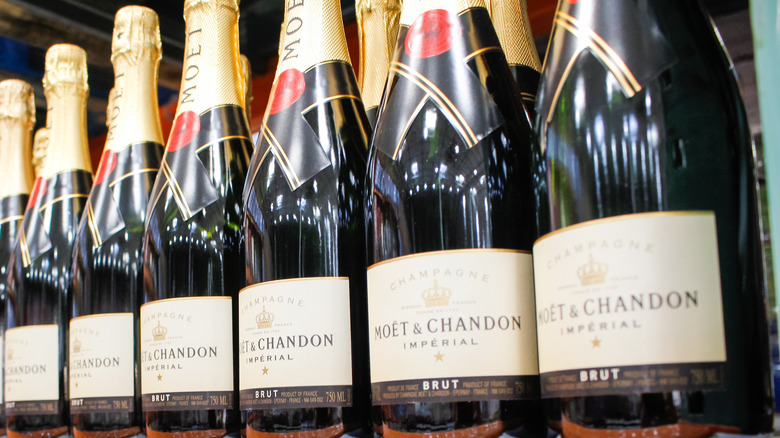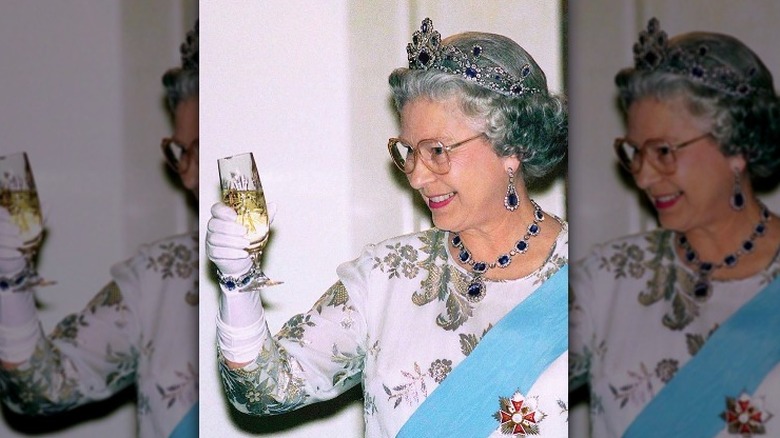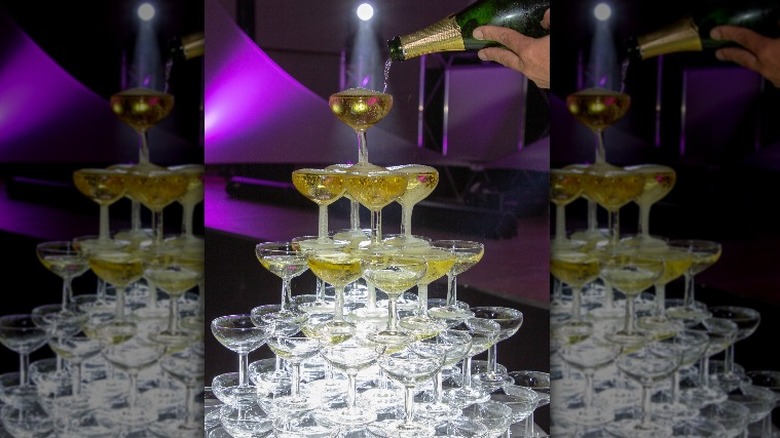Moët & Chandon Impérial Brut Champagne: The Ultimate Bottle Guide
Moët & Chandon is the No. 1 wine brand in the world. Brand Finance reports the historic Champagne House is valued at over $1.4 billion. Its value outpaces the second and third-ranked brands, sister Champagne house, Veuve Cliquot, and American offshoot, Chandon, by almost half a billion dollars. A part of the luxurious Louis Vuitton Moët-Hennessy (LVMH) company, Moët & Chandon produces over 30 million bottles of Champagne annually, reports Vinepair. The most significant percentage of this production is for the non-vintage brut style, very dry Champagne, Moët Impérial Brut.
It is a clean, crisp sparkling wine made in the traditional method from chardonnay, pinot noir, and pinot meunier grapes that is over 150 years old, with complexity, elegance, and a balanced 12% alcohol (via Drizzly).
It sparkles on red carpets and backstage at awards shows, including holding the spot as official Champagne of the Golden Globes for over 25 years, reports Forbes. It has garnered appearances on the big and small screens in films ranging from Pretty Woman, Titanic, Moonlight, and In the Heights, to episodes of Friends, Sex and the City, and The Morning Show, notes Product Placement. It is loved by royalty and celebrities, including Snoop Dog, Scarlett Johansson, Roger Federer, the Royal Family, and the late Queen Elizabeth II.
With all this pomp and circumstance, let's dive into what makes this historic bottle so remarkable.
Moët & Chandon first produced Brut Impérial Champagne in 1869
Maison Moët et Cie (Moët & Company) began in Epernay, within the Champagne region of France, in 1743 by wine trader Claude Moët, Vinepair reports. In 1973, the house officially became Moët & Chandon when the company expanded to California. However, the partnership between the Moët and Chandon families began in 1832. Then, Claude Moët's great-grandson, Victor Moët, partnered with his brother-in-law, Pierre-Gabriel Chandon de Briailles, joining the families together in marriage and business, Saucey adds.
The first bottles of Moët Brut Impérial arrived in 1869 as a realization of the ultimate Moët house style. It is a non-vintage, dry sparkling wine produced by blending multiple vintages to create the iconic representation of the winery's house style. The wine is a blend of fruit grown within the Moët estate and fruit purchased from growers throughout the region. In 1801, the wine became known simply as Moët Impérial in honor of the relationship the Maison had established with Napoléon Bonaparte, setting the stage to be an icon of celebration.
Today's Moët Impérial is a blend of over 100 wines, including upwards of 30% of wine held in reserve. The combination ensures the Champagne will carry the same characteristics and qualities displayed in the previous year. For Moët, the Impérial shows a citrusy, fruit-forward palate, with a crisp, clean texture and a delicate balance.
Moët Impérial is made in the traditional method
In May 1728, King Louis XV of France established a royal decree exclusively for Champagne, allowing the sparkling wine to be delivered in bottles rather than barrels, (via Meilleur Champagne). This traditional method process, also known as méthode champenoise, includes a secondary fermentation where bubbles form within the bottle of wine, explains California Champagnes. The secondary fermentation occurs after initial alcoholic fermentation in tanks or barrels.
During this process, the wine mixes with a sugar and yeast solution, also known as liqueur de triage, is bottled, capped with a soda bottle cap, and left to begin the secondary fermentation and aging. As the yeast consumes the sugars, carbon dioxide (i.e., bubbles) forms and stays in the bottle. The sparkler then ages for several months to several years.
In the creation of the Impérial, Chief Winemaker Benoit Gouez will age the wine in the bottle on its side for 18-to-24 months, but this was not always the case for the previous selection for America.
The Champagne was formerly known as White Star in the United States. The sparkler had a higher sugar level than the traditional Impérial, details Wine Review Online. In 2011, Moët & Chandon began updating the selection to appeal to the changing American palate, preferring more of a dry style. Gouez began reducing the sugar content of the bubbly's dosage while increasing the aging time from 12-to-18 months to 18-to-24 months, Forbes reports.
Moët Impérial is plush and opulent
We tried the Champagne, finding it structured with complexity that melds with approachability. When first pouring a glass of Impérial, it is easy to be struck with how velvety and unctuous the sparkling wine looks, with the golden color of freshly harvested hay. This gives way to a stream of tiny, graceful bubbles racing to the surface in an elegant line.
The blend of 30% pinot noir and pinot meunier, with around 20% chardonnay, creates a fruit-forward palate of zesty citrus and orchard fruit for the sparkler, leading with layers of golden apple, lemon-lime, and honey. The 24 months of aging en triage, or on the lees or yeast strains, lends a bready, yeasty, baked biscuit flavor and creamy texture to the sparkler without creating a weighty palate.
There is a nice balance between fruitiness and mineral earthiness, a nod to the mineral-rich limestone soils of the 320 parcels of land throughout the Champagne region. The finish shows a mélange of orchard and stone fruit with bitter walnut and crushed stone.
Moët recommends chilling in an ice bucket for 15 to 30 minutes before serving and enjoying at a temperature around 45 F. They also suggest adding salt to the ice to keep it cold; we often add a bit of water to the bucket to speed up the process.
Toast the sparkler with breakfast, lunch, and dinner
The Impérial is perfect as an aperitif or paired throughout a meal. It is the ideal base for cocktails if you like drinking Champagne. And it comes in handy picnic size, Champagne six-packs, perfect for toasting with friends beach or poolside.
Moët suggests enjoying the non-vintage bubbly within the first three years of purchase to ensure the wine has optimal freshness and effervescence.
When pairing with food, the Maison suggests raw fish, like sushi, oysters, and of course, caviar, with the acidity of the sparkler melding with the briny saltiness of the fish. They add it is best to enjoy with delicate flavors, like succulent poached chicken or fish, to showcase the elegance and freshness of the Champagne.
Bespoke Unit shares that the wine includes a high percentage of pinot noir, adding richness and structure, making it perfect for pairing with white meats and vegetable dishes.
Though we usually prefer to sip our sparklers straight, we have found the Impérial is perfect in a white mimosa for brunch cocktails. Add the cocktail to a lunch featuring an eggy Spanish tortilla. The omelet is an unconventional food to pair with Champagne. However, the creamy potato and egg dish will highlight the yeasty character of the sparkler. And the wine's racy acidity will balance the dish's richness.
The best way to enjoy Moët Impérial is with this
Over the years, the best type of wine glass to enjoy your bubbly has changed dramatically. The first official glass of Champagne was the coupe, created in the 1830s in England, reports Advanced Mixology. Throughout the early 20th century, the coupe was the glass of choice, with celebrities sipping from shallow-bowled glasses on and off-screen, the food site adds.
As tastes changed in the late 20th century, the tall, narrow flute glass became more popular. The flute's design ensures that the sparkling effervescence of thousands of tiny bubbles remains concentrated in the vessel. The cocktail site adds that the glass also embraces the delicate aromas of the Champagne that were quickly lost when using a coupe.
Fast-forward to today, where the tear-dropped, tulip-shaped glass, with a round bowl and slightly flared lip, has become the glass of choice for enjoying Champagne. The shape ensures the bubbles remain intact while allowing for more aeration of the sparkler, like famed glass maker Ridel's Dom Pérignon glass.
Moët Impérial is priced reasonably for the quality
Commander's Palace wine director, Dan Davis, explains all you need to know about champagne. He says champagne is expensive because the production in the traditional method is laborious. It can also only come from the small region in France.
However, you can find delicious options in the non-vintage style from larger Champagne houses and grower selections. The non-vintage style is the producer's ultimate expression, telling the brand's story through the wine. Vinepair defines this flagship expression as a blend of reserve wines produced in prior years with the current vintage.
Moët's tasting panel tries over 300 wines each year during the assemblage or blending to create this consistent house style for the Moët Impérial NV. The resulting wine is a high-quality selection without an exorbitant price point. It costs around $50 in the U.S., much less than many of its counterparts, Wine-Searcher details.
Moët Impérial vs. Veuve Clicquot Yellow Label
The world's second most popular wine brand is another Champagne, Moët's sister brand, Veuve Clicquot (via VinePair). Both selections are a part of the parent company LVMH, as are Dom Pérignon and Krug Champagne. The Impérial from Moët and Yellow Label from Veuve Clicquot are both House's most approachable selections.
Each is a non-vintage, brut-style champagne blending reserve and current vintage wines. For Moët, the blend includes upwards of 100 wines; for the Yellow Label, the combination consists of 50-to-60 selections, dominated by pinot noir fruit. Each year the Yellow Label includes at least 50% of the red variety, lending a lip-smacking, fruit-forward note to the sparkling wine.
In tasting the two champagne side by side, the selection from Moët is considerably drier, with a crisp, polished vibrancy that melds with opulence. The Yellow Label is rounder and sweeter on the front palate. It reminds us of Moët's White Star's taste, with candied fruit flavors and a satiny palate.
Both of the selections are delicious but different. If you prefer crisp, refined champagne, the Impérial is for you. The style is also perfect for pairing, especially with anything fried or creamy, as the acidity will cut through the richness. If you prefer a fruit-forward sparkler, the Veuve is for you.
Veuve will set you back a few more dollars than the Moët, with an average price of $67 (via Wine-Searcher).
Moët's success can be credited to a royal mistress
King Louis XV of France's powerful chief mistress, Marquise de Pompadour, believed champagne made every woman desirable. She is famously quoted as saying, "Champagne is the only wine that leaves a woman beautiful after drinking it," due to her love of Moët Champagne.
Encyclopedia.com defines this influence, noting that in the mid-1700s, the royal mistress achieved some of the most significant powers in the court while sharing a bed with the king. Still, her power surged more so when their relationship became platonic. She was a trusted friend and advisor throughout the latter part of her life, enjoying tremendous power over the king. Her sway and position influenced the types of art patronized and displayed in court, extending to advising the king on French military decisions.
While spending a royal sum on patronizing the arts, she established Paris as one of the leading cities for the arts. A friend and loyal customer of Claude Moët, the Marquise, was highly influential in ensuring Louis XV's royal court included the champagne adds LoLo French Antiques.
It is challenging to pronounce Moët Impérial
How to pronounce the beloved bottle has baffled consumers around the globe, with Saturday Night Live skits depicting the linguistic difficulty. Understandably, the articulation can be confusing. You might expect the pronunciation to be similar to escargot or haricot verts, dropping the consonant at the end of the word. So, let's set the record straight on if you enunciate the "t" in Moët, or if it is silent.
Vinepair explains that when pronouncing Moët, the "t" is not silent. Phonetically, the pronunciation is "mow," like you are going to mow your lawn, and "wet," as in the water is wet.
Hamper Emporium explains that though the company is French, the site explains the origin of the surname is Dutch. The Moët family came to France from the Netherlands in the 1400s, Vinepair adds. And though French-born Claude Moët founded the winery, the family kept the traditional Dutch pronunciation of Moët, including a hard "t."
To say the name of the champagne, you would use the traditional French pronunciation of Impérial, articulating each syllable to sound like "umm-peer-e-all."
The absolute best food pairing may surprise you
Though caviar, truffles, and lobster tails are the ultimate luxurious pairings often enjoyed with champagne, Moët & Chandon's wine quality and communication manager, Marie-Christine Osselin, prefers something a bit more accessible, french fries.
Osselin explains to Drinks Business that the best pairings with champagne are simple and clean foods that highlight the delicate characteristics of sparkling wine. Dishes should contain no more than three main ingredients not to overpower the refinement of the sparkling wine.
Though critics may consider high-end wine to pair with everyday foods, like champagne with french fries, to be unsophisticated, they are the perfect complements, explains Osselin. Fries are salty, crispy, and fried, three elements that champagne loves.
The wine's acidity cuts through the salty fried potatoes, cleansing the palate, similar to how champagne cuts through caviar's salinity and buttery character. The fat of crispy fries or potato chips coats the palate, taming the acid in the sparkler, working best with the zesty, refreshing champagne. The combination ensures each flavor component is in balance.
Moët Impérial was the central figure in a massive crime
Police in Padova, Italy, near the sparkling Prosecco region, found 9,000 bottles of fake Moët & Chandon in a shed in 2016. The Guardian reported that police arrested eight counterfeiters working in the countryside shack where they found the fake bottles of sparkling wine. The estimated value of the phony bottles was over $380,000.
The amount is a fraction of the total damage the counterfeiters could have amounted to, as the police found 40,000 Moët & Chandon labels in the shed. If that wine had made it to the open market, its value would have been over $2 million.
Italy's Guardia di Finanza, or financial guard, said it was, "One of the most significant seizures of contraband Champagne in Europe," NBC News reports. Instead of premium champagne, the bottles contained cheap sparkling wine that could have been sold in Italy and abroad.
At least the bottles didn't go to waste. Instead of being destroyed, they were donated to "associations" throughout the Veneto region, The Guardian adds. Let's hope they removed the labels before donating them.
Queen, and Queen Elizabeth II, love Moët & Chandon
Moët & Chandon is the official supplier of Champagne to the now-late Queen Elizabeth II (via Forbes). The brand has held the Royal Warrant supplying the Royal Family with their champagne since Queen Victoria was in power, Liz Palmer adds. In 1955, early in her reign, Queen Elizabeth reaffirmed the warrant.
In honor of the recent celebration of the Queen's 70-year reign, a limited edition Moët & Chandon Impérial Rosé Champagne Jubilee was released.
Story of Song reports the first song to transport English rock band Queen onto an international stage across the pond was "Killer Queen." Though the song is about a high-class call girl, not the late Queen of England, we appreciate the band's nod to the brand's quality. The opening lyrics begin, "She keeps Moët & Chandon in her pretty cabinet," referencing that the song's subject is a lady of the night, but she is classy.
As to whether Queen Elizabeth II appreciated Queen? Her tapping the first few bars of their iconic song, "We Will Rock You," on her teacup in the opening skit for her Platinum Jubilee would lead us to believe so.
Gatsby likely drank Brut Impérial
Product placement is a lucrative way for film and television producers can add a little extra income to the production budget. Investopedia defines it as embedded advertising where branded products or services are a part of productions that target large audiences.
Watching the 2013 remake of "The Great Gatsby," it would be easy to assume Moët & Chandon paid millions to the producers as Champagne is featured prominently throughout the film. However, Forbes reports that the Champagne house was surprised by the extensive use of the sparkler as they did not contract the placement.
The decision to use the brand came from the production and costume designer of the film, Catherine Martin. Forbes explains her focus was to keep the movie as historically accurate as possible, selecting the brand based on likely availability. As the Impérial was one of the first exported abroad and of exceptional quality, it seems likely that during the 1920s Gatsby era, the bubbly would have been the brand of choice.
Martin adds Gatsby may have preferred Moët's sister, premium label Dom Pérignon; however, the premium selection did not enter the export market outside of France until the 1930s. Someone with the discerning taste of F. Scott Fitzgerald's character, Jay Gatsby, would select Moët Impérial for his lavish parties at his home on Long Island, New York.
